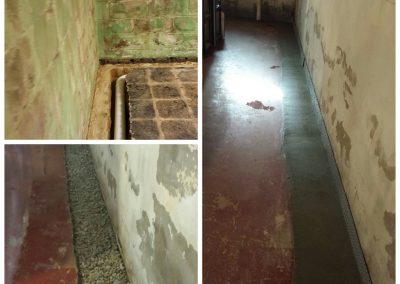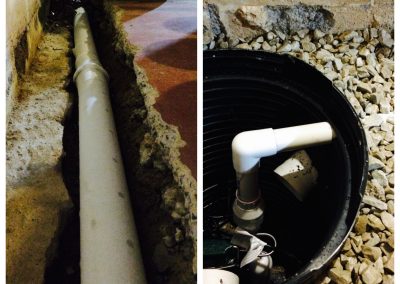French Drain Installation
OUR GALLERIES
FRENCH DRAIN INSTALLATION CONTRACTOR PHOENIXVILLE PA
Serving Pennsylvania, New Jersey and Delware
FRENCH DRAIN & BASEMENT WATERPROOFING
There are basically two ways to waterproof a house or building. The first and most common way is from the inside using a French Drain (hydrostatic pressure relief system). This way is usually more affordable than doing it from the outside. Waterproofing One has been successfully installed french drains for customers since before 1990 in all areas of Pennsylvania, New Jersey and Delaware.
The other way to waterproof a house is from the outside by sealing the exterior walls below ground level by installing a membrane or coating. This is done by digging down around the foundation walls and sealing the exterior walls from the outside. The entire wall all the way down to below the floor has t22o be covered or sealed from the outside in order for this type of waterproofing system to be effective.
When a house is built, a big hole is dug out in order to build the foundation below ground level. The soil being disturbed or removed is called “hard pan”. This soil has been there for millions of years and is naturally compacted. After the footers, foundation walls and concrete floor are constructed the basement is then backfilled using the same soil. The soil filled back is called “soft pan”. This soft pan soil around the house allows moisture or water to flow under and around the foundation slab and walls more easily. This is called a “false water table”. The false water table allows water to fill up around the basement causing what is called hydrostatic pressure until eventually the masonry fails and water starts leaking into the basement. In addition, the water building up under the concrete slab and around the foundation walls (hydrostatic pressure) will cause the soft pan soil to settle. This settlement causes voids under the foundation (footers), concrete floor and walls. If you have ever noticed cracks in the basement floor or cracks on your basement walls, it’s most likely caused by settlement. Settlement is caused by the soft pan soil sinking in the false water table.
In 1860 a gentleman named Henry French wrote a book called “Farm Drainage”. In this book he described the way to waterproof a basement or “cellar” as he called it. Today the same basic principles to waterproofing apply. The most common way to waterproof a basement is from the inside using a French Drain in the basement. The French Drain of today has been improved by the use of modern materials together with slight modifications in design but is reminiscent of the original design. These modifications make the drain work more efficiently and last longer. The process of installing modern French Drain is as follows:
WATERPROOFING FROM THE INSIDE
- Dig a trench, just past the footer to accommodate a 4 inch perforated pipe.
- Line the trench with silt fabric.
- Install weep holes to drain water from block walls (if applicable).
- Install Mira drain throughout the new drain.
- Install 4 inch perforated pipe with silt sock.
- Cover with ¾” clean stone throughout the drain to the depth of the footing.
- Install a clean out drain pipe so to unclog any future blockages.
- Cover with sand mix/ concrete to be level with the existing floor.
- Dig a sump well and install a sump well liner with lid.
- Install a sump pump with a PVC discharge pipe through the basement wall to the exterior so to divert water away from the structure.
WATERPROOFING FROM THE OUTSIDE
- Dig a trench on the outside to the footer, just past the level of the floor.
- Powerwash foundation wall.
- Clean all loose debris from foundation wall.
- Check for cracks in foundation.
- Fill cracks with hydraulic cement.
- Prime wall with primer/adhesive.
- Allow wall to dry or use propane torch to dry wall.
- Install waterproof membrane on all newly exposed foundation walls.
- Install mastic where the footer meets the bottom of the wall.
- Install silt fabric to line the entire bottom of the trench and surrounding the pipe and stone.
- Install plastic along entire wall to protect membrane.
- Install a minimum of 16 inches of ¾ clean crushed stone at bottom of the trench in the entire drain system.
- Extend drain pipe to lower elevation day light or into sump well system (if needed)
- Backfill soil to just above ground level to divert water away from structure.
Chester County, PA | Downingtown, PA | Media, PA | Haverford, PA | Bryn Mawr, PA | Malvern, PA | Wayne, PA | West Chester, PA | Chester Springs, PA | Newtown Square, PA | Concordville, PA | Glen Mills, PA | Chadds Ford, PA | Radnor, PA | Villanova, PA | Swarthmore, PA | Voorhees Township, NJ | Toms River, NJ | Nazareth, PA | Pottstown, PA | Coatesville, PA | Hockessin, DE | Main Line, PA | Ardmore, PA | Gladwyne, PA | Narberth, PA | Wynnewood, PA |Lansdale, PA | Collegeville, PA | Horsham, PA | Springfield, PA | Broomall, PA | Norristown, PA | Radnor, PA | Chester, PA | Darby, PA |
and Surrounding Areas
Get a Free Instant Estimate for French Drain Solutions!
Simply fill out and submit the form below to get started!
Waterproofing One
4093 Hollow Rd
Phoenixville, PA 19460
Serving Pennsylvania, New Jersey and Delaware
Pa Lic#: Pa057647
NJ Lic#: 13VH09291700
DE Lic#: 17-92051-13-000






